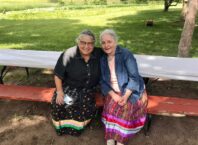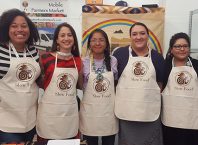Working as a Pediatrician in Native American communities since 1997, I have used photography and writing to share health success stories in health promotion materials featuring Native American health role models. So I was very excited when a 2012 McKnight Filmmaking Fellow, Norah Shapiro, offered to collaborate with me on a brief film about the Indian Health Board featuring women from our clinic who volunteered in the interest of public health.
The goal of our project was to reach out to people in the community who work with young women and their partners, parents, and youth leaders to help spread the word through social media about the most effective birth control options for adolescents and young women. You can learn more by watching our 12 minute film: What’s New in Birth Control: A Message from the Indian Health Board of Minneapolis. (View it at: http://indianhealthboard.com/resource-library.html#videos.
The event that brought the film idea into focus for me was a statement by the American College of Obstetrics and Gynecology (ACOG) in October, 2012. ACOG released a position statement establishing powerful support for the use of Long Acting Reversible Contraception (Intrauterine Devices and Implantable Hormonal Devices) as a “first line option” for adolescents and young women, whether or not they have had children. This method is safe and 99% effective, easily reversible and can last for up to 10 years. The implantable hormonal method (usually inserted in the arm) is also 99% effective and lasts for 3 years.
Women in my generation and older were raised to be fearful of the IUD, with good cause because of the infamous Dalkon Shield, withdrawn from the market in 1974 after being associated with serious injury and infection. Moms and grandmothers tend to reflexively lean away from IUDs and are less likely to educate their daughters about them. However, due to immense improvements, the new generation of IUDs is finding popularity with women of all ages.
Over the years, I have come to greatly respect the role of breastfeeding and the uterine environment for the powerful influence they hold over lifelong health. I am continually amazed at the long-reaching protective effects of breastfeeding: lower rates of diabetes, obesity, lower rates of SIDS, infant infections and more. The converse is also true of toxic exposures in utero. I often meet people whose daily lives are forever affected by preventable birth defects such as Fetal Alcohol Syndrome and the lifelong developmental aftereffects of maternal addiction and substance abuse. Fetal drug, alcohol and tobacco exposure are significant problems today despite decades of education on this topic.
There will always be chance and fate involved in how a mom’s genes match with a dad’s genes, but increasing medical evidence suggests that if we control our environmental milieu, we can actually influence the expression of genes. The ovaries (where eggs rest for many years because female infants are actually born with a full complement of eggs) and the uterus can be exposed to toxins or a healthy bodily milieu.
Did you know that the genes that formed you were once in your grandmother’s uterus because your mother was born with millions of eggs in her ovaries? The details of grandma’s pregnancy are an area of scientific interest because environmental affects like starvation or smoking have been found to linger for generations.
Environment influences a baby’s gene expression, possibly affecting generations down the road, making the uterine environment both powerful and vulnerable. With this knowledge, preparation for a healthy baby can be deliberate even if a woman has no immediate plans to become pregnant.
Young women can start years in advance of the planned birth of the baby by being healthy and fit. Family and significant others can all help by educating young women about taking prenatal vitamins and folic acid before getting pregnant to prevent spinal cord defects, avoiding environmental toxins like mercury (which is found in some fish) because it takes many years to clear our system of heavy metals, and avoiding pesticides and other harmful chemicals.
Likewise, we can educate young people about birth control choices to help them avoid unintended pregnancies. That’s what the Indian Health Board is trying to help achieve in our film. The difference is that now there are options that are much more effective than planned abstinence or methods that require daily thought.
In the modern history of birth control, we are witness to a new era. We are getting closer to the ideal. Methods are available that are highly effective, easily reversible, are associated with less side effects, are safe for women who have had children, and also for women who have not yet started a families and the methods do not require daily attention.
Native American women are achieving so much through education, talent, vision and leadership. Young people have goals. Every woman needs to decide for herself which path is right for her, taking into account her own personal feelings and preferences. She may have a trusted family member from whom she seeks advice or an elder who can provide cultural advice.
I strive to educate my patients on standard of care in medicine, that is, the best practices in medicine that should be offered to all patients regardless of ability to pay or geographic location. However, I know from working in rural areas that all of the options are not always available close to home. I want people to know that if a doctor in a rural area is unfamiliar with these new guidelines or is unable to offer Long Acting Reversible Contraception to an interested patient, the doctor can always refer to a specialist or other provider who is more experienced.
A baby only gets one chance to spend time in the uterus; I would like to see every baby given the best chance possible for full development. I hope that by educating the community about long acting and easily reversible forms of birth control we can help people plan for healthy generations to come.
Angela Erdrich, MD, is a Board Certified Pediatrician who has been working with the Indian Health Board of Minneapolis since 2010. For more info, call 612-721- 9800.






